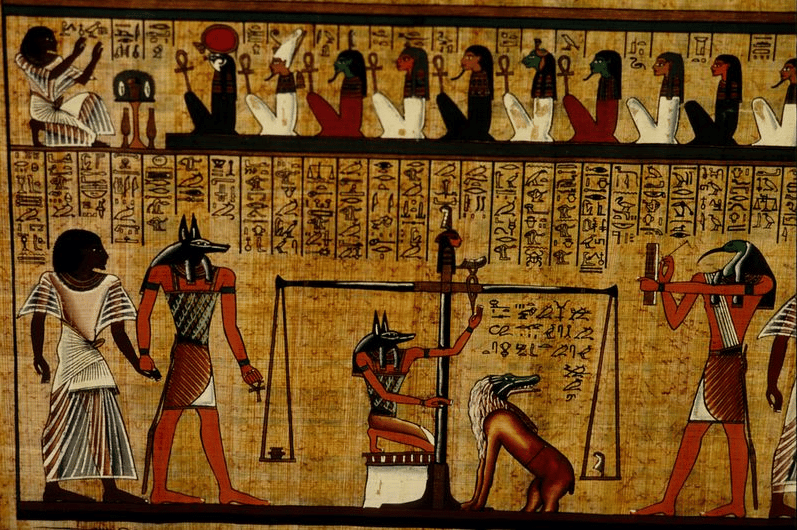
The Book of the Dead: Exploring Ancient Egypt's Guide to the Afterlife
HISTORY OF EGYPT
2/2/20254 min read
Ancient Egyptian culture is known for its rich mythology, complex gods and goddesses, and the unique way it approached death and the afterlife. Among the many artifacts and texts that have come down through history, The Book of the Dead stands out as one of the most significant and intriguing. This guide to the afterlife, full of spells, prayers, and rituals, reveals the ancient Egyptians' deeply spiritual beliefs about death, judgment, and rebirth. In 2024 and beyond, understanding The Book of the Dead not only offers a glimpse into the minds of ancient Egyptians but also provides valuable insights into their culture and worldview.
What is The Book of the Dead?
The Book of the Dead isn’t a single book at all, but rather a collection of spells and instructions meant to help individuals navigate the complex journey through the afterlife. It was primarily intended for the deceased to ensure a safe passage to the afterlife and to help them in the judgment process before Osiris, the god of the dead.
Origin: The Book of the Dead dates back to around 1550 BCE during the New Kingdom period of ancient Egypt. It evolved from earlier funerary texts, but by this time, it had become a well-established part of Egyptian burial practices.
Purpose: It was meant to help the deceased overcome obstacles, pass trials, and ultimately achieve a favorable judgment to be reborn into a peaceful afterlife.
Key Themes in The Book of the Dead
The core of the Book of the Dead revolves around the themes of protection, guidance, and divine judgment. Let’s break down the primary components of this essential text:
1. Spells for Protection
One of the most important aspects of The Book of the Dead is its spells for protection during the journey to the afterlife. These spells were written on papyrus scrolls, amulets, or coffin walls to ensure that the deceased would be shielded from dangers like demons or malevolent gods.
The Spell for Going Forth by Day: This was an essential incantation recited by the deceased, allowing them to walk freely in the afterlife without fear.
The Spell for Protection from Snakes: Snakes were often seen as symbols of chaos or death, and this spell ensured that the deceased would be safe from them.
2. The Weighing of the Heart
One of the most famous scenes from The Book of the Dead is the Weighing of the Heart. In this process, the deceased’s heart is weighed against the Feather of Ma’at, symbolizing truth, balance, and order. If the heart is lighter than the feather, the deceased is deemed worthy and is allowed to enter the afterlife. If it is heavier, it would be devoured by Ammit, the devouring goddess.
The Feather of Ma’at: Symbolizes truth and order in the judgment process.
The Heart: Represents the soul and the deeds of the person during their lifetime.
3. The Journey Through the Underworld (Duat)
The underworld, known as the Duat, was a dangerous realm filled with trials that the deceased had to pass through. The Book of the Dead provides an overview of these obstacles and the specific spells needed to overcome them.
Monsters and Gods: The deceased encounters terrifying gods, demons, and monsters during their journey.
Rituals for Survival: Specific spells would guide the deceased past these threats and ensure they remained safe.
4. The Role of Gods and Goddesses
Throughout The Book of the Dead, the gods and goddesses of ancient Egypt play a central role in the journey to the afterlife. Many of the spells are addressed directly to these deities, requesting their assistance or protection.
Osiris: As the ruler of the underworld, Osiris is one of the central figures in the judgment and afterlife process.
Anubis: The god of mummification, Anubis plays a key role in preparing the deceased for the afterlife.
Horus: The son of Osiris, Horus represents protection and guidance during the final judgment.
5. The Eternal Rebirth
At the heart of the Book of the Dead is the belief in eternal rebirth. The ancient Egyptians believed that death was not an end but a transition to a new life. If a person’s soul was judged favorably, they would live again in the Field of Reeds, a paradise that resembled an ideal version of life on earth.
The Field of Reeds: A place of eternal happiness and peace, where the deceased would enjoy a harmonious existence.
Rebirth: The concept of rebirth was central to Egyptian spirituality, symbolizing hope, renewal, and the eternal cycle of life.
Why is The Book of the Dead Still Relevant Today?
In 2024, studying the Book of the Dead provides valuable insights into the ancient Egyptians’ understanding of life, death, and the afterlife. It also serves as a profound cultural artifact that can spark discussions about spirituality, morality, and rituals in various societies.
Historical Significance: Understanding The Book of the Dead helps us grasp the complex religious beliefs of one of the world’s most influential ancient civilizations.
Cultural Connections: The rituals and beliefs in the Book of the Dead have influenced literature, art, and culture for centuries.
For teachers and students, The Book of the Dead can serve as a fascinating case study of ancient Egyptian beliefs, offering rich material for research and discussion in classrooms around the world.
Explore More with Our E-Learning Platform!
Are you ready to dive deeper into ancient Egypt’s fascinating religious beliefs and practices? Our e-learning platform offers comprehensive lessons on topics like The Book of the Dead, the Egyptian gods and goddesses, and more! Perfect for teachers and students, our courses bring ancient Egyptian culture to life through interactive lessons and engaging resources. Don’t miss out on this incredible opportunity to learn about one of the world’s most captivating civilizations. Check out our online lessons today and start your journey into the afterlife with Ancient Egypt’s most revered texts!


